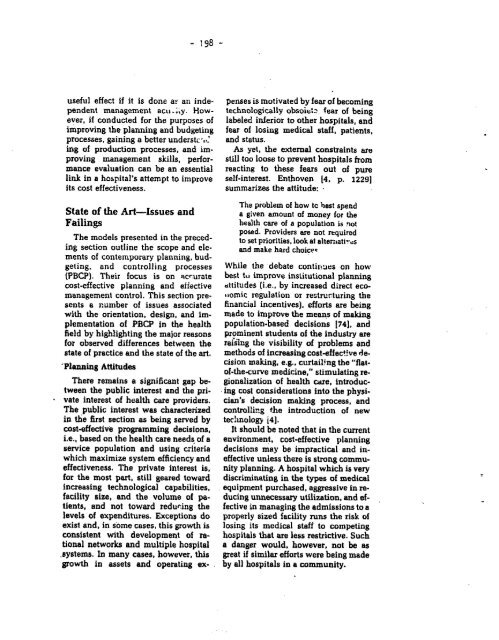BOOKS OF RtfiDIfGS - PAHO/WHO
BOOKS OF RtfiDIfGS - PAHO/WHO
BOOKS OF RtfiDIfGS - PAHO/WHO
Create successful ePaper yourself
Turn your PDF publications into a flip-book with our unique Google optimized e-Paper software.
- 198 -<br />
useful effect if it is done aF an independent<br />
management acu .;;y. However,<br />
if conducted for the purposes of<br />
improving the planning and budgeting<br />
processes, gaining a better underst ,,.'.<br />
ing of production processes, and improving<br />
management skills, performance<br />
evaluation can be an essential<br />
link in a hospital's attempt to improve<br />
its cost effectiveness.<br />
State of the Art-Issues and<br />
Failings<br />
The models presented in the preceding<br />
section outline the scope and elements<br />
of contemporary planning, budgeting,<br />
and controlling processes<br />
(PBCP). Their focus is on ccrurate<br />
cost-effective planning and effective<br />
management control. This section presents<br />
a number of issues associated<br />
with the orientation, design, and implementation<br />
of PBCP in the health<br />
field by highlighting the major reasons<br />
for observed differences between the<br />
state of practice and the state of the art.<br />
'Planning Attitudes<br />
There remains a significant gap between<br />
the public interest and the private<br />
interest of health care providers.<br />
The public interest was characterized<br />
in the first section as being served by<br />
cost-effective programming decisions,<br />
i.e., based on the health care needs of a<br />
service population and using criteria<br />
which maximize system efficiency and<br />
effectiveness. The private interest is,<br />
for the most part, still geared toward<br />
increasing technological capabilities,<br />
facility size, and the volume of patients,<br />
and not toward redur.ing the<br />
levels of expenditures. Exceptions do<br />
exist and, in some cases, this growth is<br />
consistent with development of rational<br />
networks and multiple hospital<br />
.systems. In many cases, however, this<br />
growth in assets and operating ex-<br />
penses is motivated by fear of becoming<br />
technologically obsoietc. fear of being<br />
labeled inferior to other hospitals, and<br />
fear of losing medical staff, patients,<br />
and status.<br />
As yet, the external constraints are<br />
still too loose to prevent hospitals from<br />
reacting to these fears out of pure<br />
self-interest. Enthoven 14, p. 1229]<br />
summarizes the attitude: ·<br />
The problem of how tc hest spend<br />
a given amount of money for the<br />
health care of a population is not<br />
posed. Providers are not required<br />
to set priorities, look at alterriativocs<br />
and make hard choicec<br />
While the debate contir.ues on how<br />
best tu improve institutional planning<br />
dttitudes (i.e.,, by increased direct ecou.omic<br />
regulation or restrucr.turing the<br />
financial incentives), efforts are being<br />
made to improve the means of making<br />
population-based decisions 174], and<br />
prominent students of the industry are<br />
raising the visibility of problems and<br />
methods of increasing cost-effective decision<br />
making, e.g., curtailmng the "fatof-the-curve<br />
medicine," stimulating regionalization<br />
of health care, introducing<br />
cost considerations into the physician's<br />
decision making process, and<br />
controlling the introduction of new<br />
technology j4].<br />
It should be noted that in the current<br />
environment, cost-effective planning<br />
decisions may be impractical and ineffective<br />
unless there is strong community<br />
planning. A hospital which is very<br />
discriminating in the types of medical<br />
equipment purchased, aggressive in reducing<br />
unnecessary utilization, and effective<br />
in managing the admissions to a<br />
properly sized facility runs the risk of<br />
losing its medical staff to competing<br />
hospitals that are less restrictive. Such<br />
a danger would, however, not be as<br />
great if similar efforts were being made<br />
by all hospitals in a community.

















